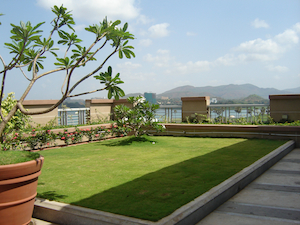

Call them what you like—green roofs, sky gardens, green terraces—these vegetated patches atop buildings are gaining ground in India. Technology and climate is playing an important role in their environmental payback.
Adopted primarily for their ability to mitigate the heat island effect in an urban environment, green roofs minimize a building's impact on the micro-climate and living habitat.
"Generally, heat is absorbed by roofs and reflected back into the environment, further heating the ambient air. In such a scenario, a green roof effectively reduces the temperature ingress. Through greenery, the water used for irrigation absorbs the heat and then evaporates, leaving both the surface and ambient air cool," says M. Anand, senior counsellor of the Confederation of Indian Industry's Sohrabji Godrej Green Business Centre (CII-Godrej GBC) in Hyderabad.
CII-Godrej GBC houses the Indian Green Building Council. Built in 2003, it was one of the first commercial buildings in India to have a large green roof. "In the last eight years that we've been operational, we have observed how our green roof has gradually attracted birds and bees to the urban area," Anand highlights.
These roofs also cool the interiors of the structure by absorbing the sun's heat and reducing the roof's heat conductivity. "This has a consequential effect on the air conditioning load and overall energy consumption," says Ashish Rakheja, COO of Spectral Services Consultants Pvt Ltd. Moreover, experts add, such roofs act as noise barriers and provide sound insulation for buildings under flight paths.
Carbonization is another factor. As plants reduce CO2 levels in the ambient air and overall pollution, used in green roofs, certain species provide carbon sequestering and improve air quality in and around a building. "To improve the air quality for its occupants, oxygen-generating plants are grown on the roof, and the fresh air generated into the building improves both the indoor and ambient air quality," Rakheja adds.
Install Considerations
Testing the roof's structural strength is a primary precaution that needs to be taken, experts say. According to Suvarna Sathe, landscape architect at Sathe Architects, the kind of material used in laying the roof can reduce the overall load. "Earlier, the layering of a green roof involved brickbat coba at the base topped with sand, geotextiles and then mud and manure," she explains. "But, this would relatively increase the structural load."
Today, drain cells replace brickbat coba and are topped with sand and geotextiles. Above this, a combination of coco peat, compost and soil helps to reduce the overall load by 60%, experts in the region say. Waterproofing is mandatory, they also advise.
Choosing Your Turf






























Post a comment to this article
Report Abusive Comment